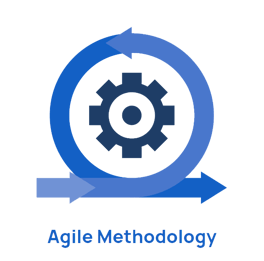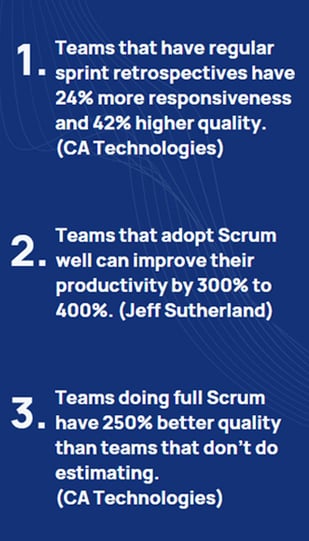No organization can afford to stand still. There are always new challenges to meet, and better ways of doing things. To stay competitive, organizations are fundamentally rethinking their product and service portfolios, reinventing their supply chains and pursuing large-scale organizational restructuring and digital transformation in hope of boosting profits.
The traditional change management process, often heavy and characterized by lengthy timelines, and clunky rollouts — won’t cut it right now. The type of change management required in this moment is quick, agile, and (in many cases) virtual.
What is Agile Change Management?
Agile change management is the adaptive and iterative planning and execution of change management practices that encourage flexibility and speed. If organizations want to make effective change, they need to recognize and deal with the principles of how change happens within agile organizations and have the tools to make the work happen.
Agile change management is a way of adapting to changes in a fast and flexible manner, rather than following a rigid plan.
Agile Change Management is the new approach to change management. It's an increasingly popular strategy undertaken by agile teams looking to adapt and embracing oncoming change in today's fast-paced business environment in order to stay ahead of the curve. Agile Change Management is a natural extension of Agile development methodologies which set out how best to create a ‘production line’ that frequently delivers tangible change in the form of new features and functionality.
Agile change management partners the change management activities with the incremental delivery from each of the sprints and/or increments of Agile development.
Check out our booklet on Agile PI Planning in Hybrid Teams.
Benefits of Agile change management
Agile change management enables companies to drive growth while optimizing costs and at the same time improving efficiency and competitiveness with the goal of achieving more business agility.
Always being attentive to the needs and desires of the end customer, not “stressing” over the changes in course and corrections required and having a spirit of collaboration that improves work performance are three characteristics of the Agile methodology that make it very suitable for change management scenarios and innovation.
- Embrace a “test-and-learn” approach

Recent events have confirmed what many change leaders already knew — though your change vision is critical to driving alignment and buy-in, that picture will seldom stay the same from the start of a change project to its finish. Anticipate change, consistently capture the next opportunity, quickly fill people capability gaps and quickly deploy teams to solve the challenge at hand.
- Shift from long-term to short-term accountability
The virtues of the shift from annual performance reviews to frequent check-ins should be apparent to leaders looking to drive rapid behavior change. More frequent feedback enables real-time coaching and allows managers to place the emphasis on what is most needed from the employee in that moment.
Organizational change management
When your organization undertakes projects or initiatives to improve performance, seize opportunities or address key issues, they often require changes; changes to processes, job roles, organizational structures and types and uses of technology.
This is where change management comes in. Change management is the discipline that guides how we prepare, equip and support individuals to successfully adopt change in order to drive organizational success and outcomes. It's a structured approach that ensures changes are implemented thoroughly and smoothly and in collaboration with stakeholders, and have the desired impact. Change management is especially powerful in agile organizations that, by nature, are constantly changing
The Agile approach
Staying competitive in an era of disruption is bringing new and urgent demand for change. When the rules of business are being frequently rewritten, companies need an approach to change that is agile, focused on results, and manageable.
Agile change management process
Agile approaches for projects have been in use for more than a decade, mainly by software development teams. The Agile approach differs by using short but regular cycles that deliver frequent results to users.
Continuous small incremental changes and regular evaluation reduce the implementation risk and make it easier to stop non-profitable projects before they incur huge losses. The flexibility to revise and re-prioritize projects at an early stage is essential.
With Agile you stay focused on what matters, and continuously adapt to the latest information, not what you predicted at the start. Creating an early return on investment also helps to fund more deliveries that take place frequently throughout the life of the change initiative.
Having seen the benefits delivered within IT departments, organizations are now starting to adopt Agile at the enterprise level and implement Agile ways of working across their organization. Agile gives leaders a framework to maintain a balance between running the business and changing the business to ensure growth through innovation.
Agile change management plan
Successful change management relies on four core principles:
- Understand Change. Focus on helping employees recognize and understand the need for change, raise awareness of the various challenges or problems facing the organization that are acting as forces of change.
- Plan Change. Effective change needs a plan that is right for your organization. Once the organization is ready to embrace change, managers must develop a thorough and realistic plan for bringing it about, including any unknowns or roadblocks that could arise during the implementation process and would require agility and flexibility to overcome.
- Implement Change. After the plan has been created, all that remains is to follow the steps outlined within it to implement the required change. Whether that involves changes to the company’s structure, strategy, systems, processes, employee behaviors, or other aspects will depend on the specifics of the initiative.
- Communicate Change. Successful change management requires effective communication with both your team members and key stakeholders. Link the changes you’re planning to the organizations mission or vision statements to help people see the bigger picture and practice good stakeholder management.

Agile organizational change management
Executives task themselves with making strategic decisions that’ll improve the organization as a whole, but, all-too-often, decisions are made individually and then communicated to the wider C-suite. This is where digital workplace tools that enable change and transformation and encourage collaboration can really help.
Instead of making decisions as individuals, C-suite execs can instead propose ideas, discuss feedback, and get sign-off from one easy-to-access portal. Working more cooperatively in this way will lead to better overall decision making across the organization.
Businesses now have the data to connect the dots across silos, demanding a more collaborative strategic response. Implementing a suite of collaboration tools improves transparency. Not only between executives, but also across the wider organization.
Change management tools
Using SharpCloud as a change management tool for your business change management allows you to visualize and understand your past, current and future business environment, allowing you to make better decisions for your teams to drive results.
Change management in Agile environment
With new customer needs to cater for, new innovations to consider implementing, and new employee expectations to meet, many businesses can fail to keep up. The coronavirus pandemic has changed the way we work – if not forever, then at least for the foreseeable.
With organizations operating virtually, online collaboration platforms are likely the fastest and most effective way to drive understanding of your change efforts and recruit the cadre of people who will champion the transformation. With the right collaboration platform in place, tracking the latest technological advancements and letting teams work more cooperatively is less challenging. You can share IT roadmaps, better govern internal innovations, and manage projects in a more concerted fashion.
An Agile approach to change management
A company of the future is one that understands the changing dynamics between the company, its employees and customers and can deal with constant change by creating flexible, agile, and decentralized environments that can execute autonomously, yet are working to achieve a shared, clear vision. The digitally enhanced and richly connected world we live in today creates new challenges and opportunities for designing effective collaboration and communication for this way of working.
The right solution provides value-added capabilities such as managing work flows, increasing collaboration between work groups and allowing content creators to self-publish. It makes progress fast and simple. It allows users to easily personalize their views of complex issues and understand them by sharing multiple dimensions of knowledge, updated by contributors in real time. It is this transfer of knowledge, more than the IT itself, which will keep enterprises effective, competitive and Agile in the future.

